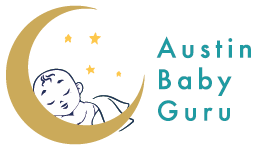*This blog post contains affiliate links for products that we think highly of. If you click through and make a purchase, I may receive a commission (at no additional cost to you). ABG links to these products because of their quality and not because of the commission we receive from your purchases. The decision is yours, and whether or not you decide to buy something is completely up to you.
Why Swaddles “Work”
When human babies are born, they are very dependent on their parents, require 24/7 care, and typically want to be held close. Because you cannot always hold or wear your baby (please sleep when baby sleeps!), swaddles are great tools for helping your baby feel held and safe. Swaddles mimic the womb, especially in their early days or the fourth trimester– a crucial time for connection, growth, and attachment.
While you’ve probably heard us use this term in regards to postpartum parents, babies also experience the fourth trimester. During the first three months of life, babies are often settled and soothes when we mimic some of the environmental and behavioral elements they were used to in utero. Again, swaddles can feel like the snug hold of the womb, which can calm the Moro or startle reflex. Have you ever noticed a baby throw their arms out then cry? With a swaddle, babies are less prone to this startle-upset cycle.
Additionally, swaddling helps babies learn to sleep on their backs, which is recommended for safe sleep. Swaddling is one of the factors that lowers the risk of SIDS; we are not entirely sure why, but it is suspected that swaddling lowers the likelihood of early rolling. That said, swaddling is recommended to be ended when 1. Baby rolls over or 2. Baby reaches 12 weeks of age (because most babies will roll between 3-5 months), whichever comes first. The exception to this rule is when baby is sleeping in a Snoo. This is because the Snoo swaddle doesn’t allow baby to roll over.
The next step is often swaddle sacks. When baby is a bit older and more mobile, these offer them the warmth of a blanket, while also preserving safe sleep.
Some babies don’t seem to enjoy the swaddle but also do not settle well with their arms free. Often when babies do this, it is a sign that a snugger swaddle will work. All of this said, not every baby needs or wants to be swaddled. If your baby is happy and sleeping on their back without a swaddle, great!
Swaddles We Love
You are going to get lots of data from your little one. You’ll learn what they prefer when it comes to swaddles. We often recommend having simple swaddle blankets AND 1-2 “cheater” swaddles on deck to try. Some of our favorites are below:
Newborn Swaddles: Babies sleep on their back, and it’s safe for them to have their arms along their sides inside the swaddle until they learn to roll over or until 12 weeks of age, whichever comes first. Newborn swaddles are more confining and womb-like.
- Village Baby Swaddling/Receiving Blanket. This is a more traditional, unstructured swaddle blanket. Check out my video where I teach folks how to double swaddle with “bat wings;” it’s a baby-favorite. This method is great for babies who break out of the “cheater” swaddles or seem to dislike swaddling.
- The Ollie Swaddle
- SwaddleMe by Ingenuity Original Swaddle
- HALO Sleepsack Swaddle
Transition Swaddles: These swaddles are designed for older babies, especially babies that have started to roll over and need to be sleeping arms-out. They are meant to support your baby in adjusting to eventually sleeping swaddle-free.
Please note that weighted sleepers and sleep sacks are no longer recommended under the new safe sleep guidelines under American Academy of Pediatrics. (CW: mention of infant loss.)
ABG is Here for You
We want to support you in the transition of adjusting to life with baby. Your baby’s sleep and your sleep matter deeply to us at Austin Baby Guru! We are here to offer doula support, classes, and referrals. We invite you to reach out if you want help preparing for baby!









0 Comments